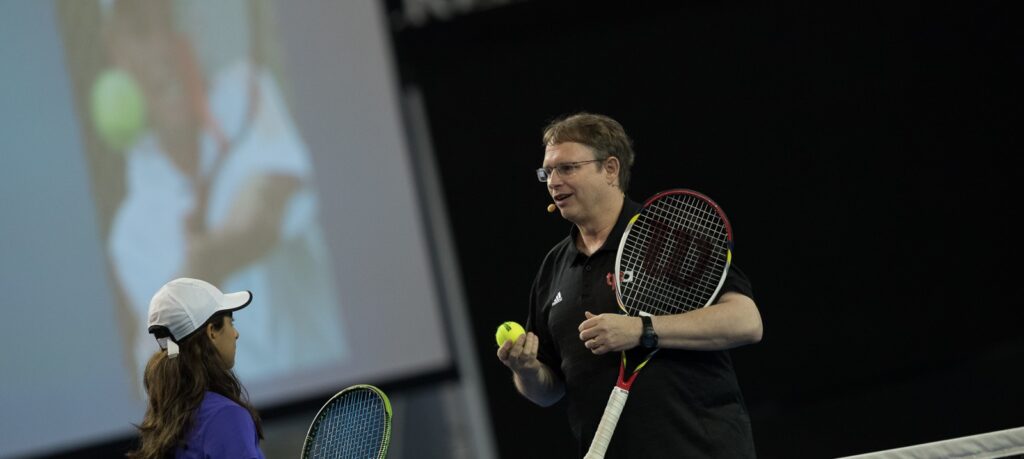
Photo credit – Front Line Studios: Australian Open Grand Slam Coaches Conference 2017
NET-PLAY:
This is part two of a 2-part series looking at the Approaching & at Net point situation. For Part 1, click here. In this article, we will explore Net-play. Keep in mind that, except in doubles when the point can start with a player at net, all net play flows from approach shots.
TACTICAL CONSIDERATIONS
It is critical to keep in mind that ‘Tennis is a game of reception then projection’. If a player does not receive the ball well, it adversely affects how they send it.
This is especially true of net play. For example, compared to a groundstroke or serve, a volley is a far less complicated action. However, if it is so ‘simple’, why do so many players struggle with volleying? Part of the reason is the higher reception challenge. The ball often comes quicker, higher, lower and wider than typical groundstrokes. Adaptability is essential for successful net play.
Being at net provides multiple tactical advantages:
Space Advantages:
- More angles are available to make opponents move/hit away from them.
- The opponents’ space is cut off.
Time Advantages:
- Taking the ball earlier takes time away from an opponent, making their reception more challenging.
- Depending on the height of the ball, net players can hit the ball with more of a downward angle (e.g. a high volley or overhead), allowing for more power shots. This also can take an opponent’s time away since a faster ball will get to them quicker.
The Net-play options ‘tree’ below outlines the main possibilities. For example, following the green elements down the tree, we see a volley from the Centre Lane at mid-court. It is a flat, defensive ‘block’ sent down-the-line.

TACTICAL ‘PACKAGES”
We can combine options to create useful Net-play ‘Tactical Packages’. These include some of the most common volley & overhead options players should have in their ‘toolbox’ (But not every possibility). Each Tactical Package is wrapped around the 3 Phases of Play:
1. Offensive
These are options for when the reception is not as challenging, and the player can gain the advantage with power (hitting with more pace to challenge the opponent’s timing) or precision (hitting with more accuracy to move an opponent or hit away from them).
2. Neutral Shots
These are options for when the reception is somewhat challenging and the goal is to prevent the opponent from having an advantage. For example, if the net player is further back and the ball is received net level or below.
3. Defensive Shots
These are options for when the reception is very challenging, and the player is trying to neutralize the opponent or survive the shot. Defensive shots can sometimes be converted to a ‘Counter’ which ‘turns the tables’ on the opponent.
PRACTICING
It is most effective to train the approach coupled with the volley. When training volleys, a player only starts already at the net when playing doubles. Otherwise, their volley always flows from the approach and is based on the approach they make and from where.
Since net play requires quick adaptation, training decision-making is critical. As mentioned earlier, it is not the execution of the simple volley action that is the most challenging aspect of volleys; it is the split-second decision of when to perform which type of volley. Training all three Phases of Play and the accompanying decisions from net and mid-court locations is essential. Ideally, training all 3 Phases of Play from a specific location would be the most effective way to organize a session.
CONCLUSION
There are multiple tactical advantages of coming to the net. However, handling the reception challenge must be trained with a priority on decision-making. All three Phases of Play must be trained to develop an effective net player. Net play flows from approach shots, and training both together is most effective.
Leave a Reply